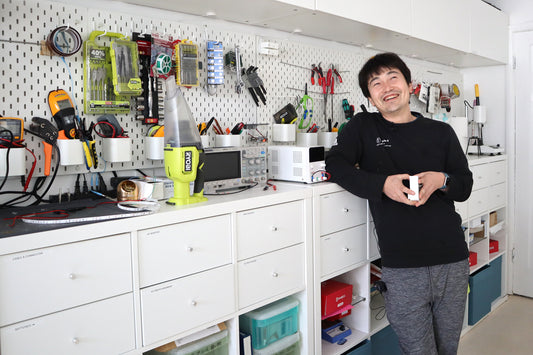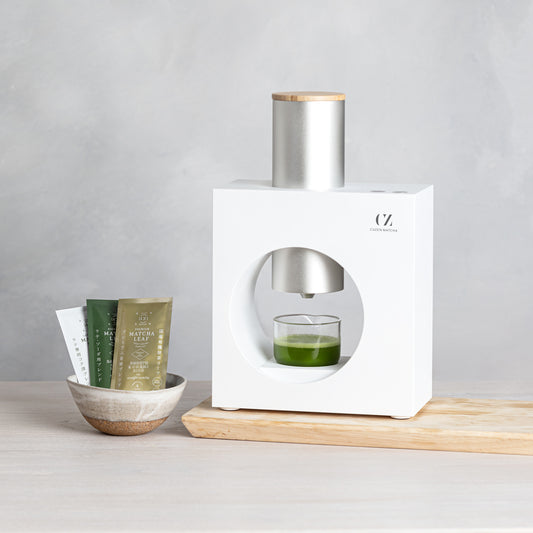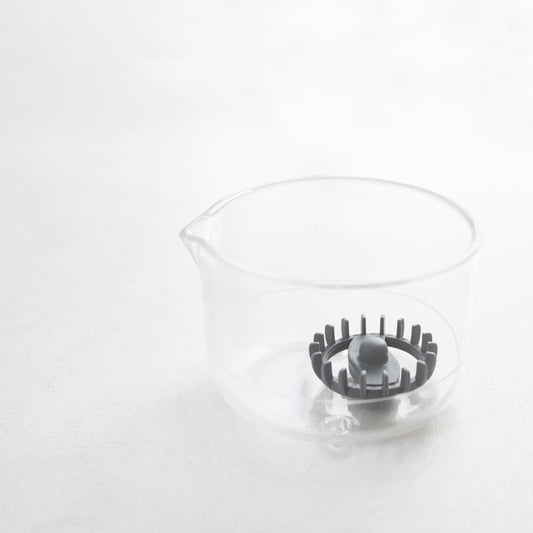

Picking ichibancha
On a clear spring day, Cuzen founder Eijiro Tsukada and Cuzen Japan Country Manager, Shino, joined our farming partner for an ichibancha handpicking event in Kagoshima Prefecture’s city of Kirishima. Shino shares an account of their day.
Contents
- A unique opportunity
- Satsuma-style handpicking
- Demonstrating gratitude
- Determining harvest time
- The baby tea farm
- Hospitality at the tea farm
1. A unique opportunity
A firsthand experience with pre-ichibancha handpicking
The ichibancha is the first harvest of the year, and this spring, our supplier hosted a pre-harvest event, inviting community members to pluck the season’s first leaves. In a normal year, the full ichibancha harvest happens in mid- to late-May, but due to a warmer season, the ichibancha harvest started earlier in the month. When the farmer told us that the first sencha tea leaves of the season were ready, I eagerly joined around 30 people for the event. I was so excited to connect my morning cup of tea with the physical experience of standing on the soil and touching the leaves.
Cuzen founder, Eijiro Tsukada, joins others in handpicking tea leaves at the farm.
---Sencha vs Tencha---
Sencha
Green tea that is grown in direct light and steeped in hot water before drinking.
Tencha
Green tea that is shaded for two weeks or more. It is made into matcha after being ground and whisked into hot water.
2. Satsuma-style handpicking
One handpicking method among many
Techniques of picking tea by hand can vary from region to region and farm to farm. Our suppliers use a tea-picking style called 'satsuma,' or "double-handed picking." In this method, shoots are plucked between both hands. In the beginning, it is difficult to know how to correctly place your hands and how to apply force. It does get easier with practice, though. The shoot is the green stem that grows from the brown branches. The farmer showed us how to gently cradle the shoot with the two nearest leaves, using both hands. This way, the shoot remains untouched. You then pull towards yourself, plucking the leaves and the shoot all at once.
The proper hand position for the satsuma-style plucking.
3. Demonstrating gratitude
The fertilizer of thanksgiving
After the event, farmers give the tea plants "oreigoe," or the “fertilizer of thanksgiving.” In a show of gratitude for the tea leaves, the plants are fed natural, non-toxic fertilizers. The organic fertilizers are then broken down by microorganisms in the soil. This makes it easier for the plants to absorb the nutrients.
4. Determining harvest time
We can just tell
The day before tea-picking, we visited the farmers and drove around the tea fields with them. There were so many fields spread here and there, I wondered if I would forget which field had what variety of tea. The farmers said that doesn’t happen. “This is Yabukita,” the farmer pointed out a variety growing in one field as we drove past. “That is Benifuki,” he continued. “This is Okumidori,” he nodded at another. I thought, “How can they tell the varieties apart?” My mind was full of questions. “When is the best time to pick tea?” I asked. The answer was impressive. They can just tell. This is the skillful technique of the farmers. If the tea leaves are harvested at the wrong time, the leaves will not have the best flavor. The ideal time to harvest tea also varies depending on the location of the farm and the variety of tea. During this season, the president of the company wakes early every morning to visit each of the many tea fields. He examines the conditions of the leaves and decides which field to harvest from that day. He has to be strong, maintaining keen observation with very little sleep.
The tea leaves that are used to make matcha get covered with a silver sheet.
Tea-harvesting is complicated and there is an order in which leaves are picked.
---Order of harvest---
First, ichibancha sencha
Second, ichibancha tencha
Third, nibancha sencha
Fourth, nibancha tencha
…and so on for several months.
5. The baby tea farm
Steadily growing for upcoming seasons
Near the area where we picked tea, the baby tea farm–a newly planted field–was also growing. Like the other fields, the baby tea farm is located on top of a mountain and surrounded by tall trees. This is to protect the tea plants from pesticides scattered in the air by nearby farms. It takes several years before they are ready for harvesting. Until then, farmers check the moisture level of the soil and fertilize the tea trees, so that they will grow and thrive.
The farmers plant trees around the baby farm to keep pesticides from blowing onto the plants.
6. Hospitality at the tea farm
Nurturing hands for family and friends
I am always impressed by the hospitality of the tea farmers, especially that of the women. The mother of the president entertains all the guests. Whenever I visit, they always serve us home cooked food that fills our stomachs. On the day of the tea-picking, the women started early in the morning. We met at the tea farm at 8:00 a.m. The mother had woken up early to make rice balls and prepare tempura with the new tea leaves, in order to serve the participants. Under the pleasant blue sky, I felt happy from the bottom of my heart.
While I was at the farm, I kept thinking about the experience of plucking the first leaves of the season, seeing the lush fields of tea, and being nourished at the table of the farmer. As much as I wished each Cuzenist could have been there with me, I know that sharing my visit and photos with Cuzenists will deepen their daily ritual. I hope someday we can organize our circle of matcha lovers to visit together.
We were served freshly-harvested bamboo-shoot sashimi, a frothy bowl of matcha and a sweet.
Related products
-
Organic Matcha Leaf packets
Regular price From $17.00USDRegular priceUnit price / per$17.00USDSale price From $17.00USD -
Matcha Maker Starter Kit
Regular price $299.00USDRegular priceUnit price / per -
Organic Single Origin Matcha Leaf
Regular price From $45.00USDRegular priceUnit price / per -
Whisking cup
Regular price $15.00USDRegular priceUnit price / per












